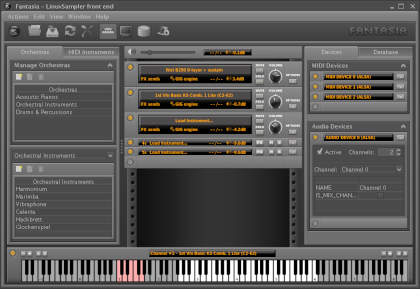Copyright © 2023 Grigor Iliev <grigor@grigoriliev.com>
This document is released under the terms of the GNU Free Documentation License.
Updated: March 2023
Table of Contents
Table of Contents
Fantasia is an opensource, platform-independent, GUI front-end for LinuxSampler, written entirely in Java.
Table of Contents
Currently, there are installers for Linux, macOS and Windows. Latest release can be downloaded from HERE.
Fantasia is packaged as a self-contained Java application. Thus, there are no requirements.
To build Fantasia from source you need JDK version 11 or higher and the maven tool. To build the installers, you need the Ant tool.
Table of Contents
If you want to build Fantasia from source, first make sure that all requirements are met.
To build from GIT, first clone the following projects:
Then follow the steps in the next section.
To build Fantasia, first set the
JAVA_HOME environment variable to point to your JDK
directory. If the JDK is installed in /opt/jdk-17 directory, this can
be done by issuing the following command:
export JAVA_HOME=/opt/jdk-17
Windows users should do something like:
set JAVA_HOME=c:\jdk-17
Go to each directory in the same order as specified above and issue mvn install.
If you want to build an installer, cd to jsampler-fantasia and
issue: ant -f jpackage.xml
If the build is successful, the installer will be located in the target
directory.
Note that you must have jpackage command on your path. If you don't, you must either add
the path to jpackage command to the PATH environment variable:
export PATH=$PATH:/path/to/jdk/bin
or edit jsampler-fantasia/jpackage.xml and replace the value of jpackage.cmd property with the absolute path of the jpackage command:
<property name="jpackage.cmd" value="/path/to/jdk/bin/jpackage"/>
Note that jpackage command is available in JDK version 14 or later.
Table of Contents
Orchestras feature is like bookmarks/favorites for instruments. Instead of having a thousands of unsorted instruments you can categorize your most used instruments for quick access by adding them to orchestras. You can create an arbitrary number of orchestras and in any orchestra you can add an arbitrary number of instruments.
Note
Orchestras are not handled by the back-end (LinuxSampler) and
does not depend on the Instruments Database. The
orchestras are handled by JSampler and are stored on the local machine
in <jsampler-home>/orchestras.xml. To port the
orchestras to another machine just copy that file.
Manage Orchestras tool buttons:
 Create new
orchestra
Create new
orchestra
 Edit
selected orchestra
Edit
selected orchestra
 Remove
selected orchestra
Remove
selected orchestra
To create a new orchestra, click on the Orchestras tab then click the button in the Manage Orchestras tool:
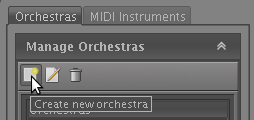
Then choose orchestra name and description and click button.
To remove an orchestra, select the orchestra and click the button. To edit an orchestra, select the orchestra and click the button, or just double-click the orchestra to edit.
Tip
To change the position of an orchestra in the orchestra list, select the orchestra and use Alt+Up Arrow and Alt+Down Arrow to move the selected orchestra up/down. You can also use Alt+Shift+Up Arow to move the selected orchestra on top and Alt+Shift+Down Arrow to move the selected orchestra to bottom.
Managing Instruments tool buttons:
 Add new
instrument
Add new
instrument
 Edit
selected instrument
Edit
selected instrument
 Remove
selected instrument
Remove
selected instrument
To add a new instrument to orchestra, first select the desired orchestra from the combobox then click the Add new instrument button:
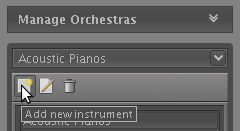
Tip
The easiest way to add an instrument to orchestra is to right-click an instrument in the Instruments Database, then select and choose the orchestra to which to add the selected instrument. Note that you can select and add more than one instrument to orchestra at once.
To remove an instrument, select the instrument and click the button. To edit an instrument, select the instrument and click the button, or just double-click the instrument to edit.
Tip
To change the position of an instrument in the instrument list, select the instrument and use Alt+Up Arrow and Alt+Down Arrow to move the selected instrument up/down. You can also use Alt+Shift+Up Arow to move the selected instrument on top and Alt+Shift+Down Arrow to move the selected instrument to bottom.
To load an instrument from orchestra to a sampler channel, right-click on the instrument, select , then choose on which channel to load the selected instrument. You can also load an instrument from orchestra to a sampler channel using the instrument chooser of the sampler channel - click Select instrument from orchestra radio button, choose orchestra and isntrument from the comboboxes and click button
Table of Contents
The sole purpose of the MIDI instrument mapping is to provide a way to change the loaded instrument on a specific sampler channel through the MIDI keyboard by switching to different MIDI bank/program. To do that you need at least one MIDI instrument map with MIDI instruments mapped for the desired MIDI banks/programs and to assign that map to the sampler channels which instruments should be switched using MIDI bank/program changes.
Note that when stopping LinuxSampler all MIDI instrument mappings are gone forever, so it is crucial to export the MIDI instrument maps before quiting your session to be able to load them again next time you start LinuxSampler. This can be done by choosing → → .
MIDI Instrument Maps tool buttons:
 Add MIDI
instrument map
Add MIDI
instrument map
 Edit
selected MIDI instrument map
Edit
selected MIDI instrument map
 Remove
selected MIDI instrument map
Remove
selected MIDI instrument map
To create a new MIDI instrument map, click the MIDI Instruments tab in the Left-Side pane then click the button.
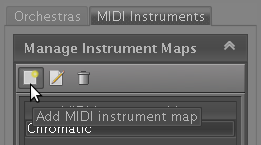
Then choose map name and click button.
To remove a map, select the map and click the button. To edit a map, select the map and click the button, or just double-click the map to edit.
Managing MIDI Instruments tool buttons:
 Add new
MIDI instrument
Add new
MIDI instrument
 Edit
selected MIDI instrument
Edit
selected MIDI instrument
 Remove
selected MIDI instrument or bank
Remove
selected MIDI instrument or bank
To map a MIDI instrument, first select the desired MIDI instrument map from the combobox then click the Add new MIDI instrument button:
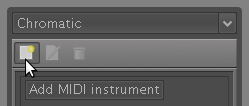
Tip
The easiest way to map a MIDI instrument is from the Instruments Database.
To remove a MIDI bank/instrument, select the MIDI bank/instrument and click the button. To edit a MIDI instrument, select the MIDI instrument and click the button, or just double-click the MIDI instrument to edit.
To assign MIDI instrument map to specific sampler channel, click the button to expand the channel options pane then select the desired map from the MIDI Instrument Map combobox:

Currently, MIDI instrument maps can be exported as:
LSCP script (*.lscp)
Text file (*.txt) - suitable for printing
Web page (*.html) - suitable for browsing
Rosegarden device file (*.rgd)
To export the current list of MIDI instruments, choose → → . You can specify the file format by entering the file extension or by selecting the desired file type from the list. If the file type is not specified and file extension is not entered, the default format is LSCP script.
Table of Contents
The communication between LinuxSampler and its front-ends is TCP/IP based, which provides an option the sampler to be controlled from another computer or device, and while instrument loading is a regular task in the sampler, there should also be a convenient way to browse and load instruments (located on the sampler box) from a front-end launched on a remote host. This need is well covered by the Instruments Database. However, this is not the only purpose of the Instruments Database. It is a great tool that helps you to not get lost in your instrument collection, providing you a flexible way to create your own tree structure and to organize your instruments in more than one way, without moving or altering the instrument files located all over your hard drives. Another great feature is the search engine with enhanced search capabilities providing you fast and easy way of finding instruments by various criteria.
It is crucial to understand that, unlike Orchestras, the Instruments Database is handled by LinuxSampler, not by JSampler, and by default the database file is located in /var/lib/linuxsampler/instruments.db on the host where the back-end is started.
Note that you can have more than one instruments database and you can specify which one to be used on LinuxSampler startup. To create a new database file issue the following command:
linuxsampler --create-instruments-db my_instruments.db
which will create a new database file called my_instruments.db in the current directory.
To start LinuxSampler using the newly created instruments database use the --instruments-db-location option:
linuxsampler --instruments-db-location my_instruments.db
To backup the instruments database just copy the database file.
Choose → to bring up the Instruments Database window, or click the corresponding tool button. Initialy, the instruments database is empty, so you should manually create the desired directories and add instruments to them.
To create a new directory, select the directory, in which the new directory should be created and choose → , or right-click a blank area and choose .
To add instruments to specific instruments database directory, go to that directory and select → submenu, where you have two options - to scan a specific instrument file and add the instruments in that file to the instruments database or scan a file system directory for instrument files and add the instruments to the instruments database.
Basic commands:
Cut - → , or right-click on a selected file or directory and choose or Ctrl+X
Copy - → , or right-click on a selected file or directory and choose or Ctrl+C
Paste - → , or right-click a blank area and choose or Ctrl+V
Rename - → , or right-click on a selected file or directory and choose or press F2
Delete - → , or right-click on a selected file or directory and choose or press the Delete key from the keyboard
Tip
This commands also work on a multiple selection.
To load an instrument to a sampler channel from the Instruments Database, right-click on the instrument and choose , then choose the sampler channel where the instrument should be loaded to. Note that you need to have at least one sampler channel created, otherwise the submenu is disabled.
To add an instrument to MIDI instrument map from the Instruments Database, right-click on the instrument and choose , then choose the MIDI instrument map to which to add the selected instrument. Note that you need to have at least one MIDI instrument map, otherwise the submenu is disabled. For more info read MIDI Instruments.
Tip
To add more than one instrument from an instrument directory at a time, select the instruments and right-click on one of the selected instruments.
To add an instrument to orchestra from the Instruments Database, right-click on the instrument and choose , then choose the orchestra to which to add the selected instrument. Note that you need to have at least one orchestra, otherwise the submenu is disabled. For more info read Using Orchestras.
Tip
To add more than one instrument from an instrument directory at a time, select the instruments and right-click on one of the selected instruments.
